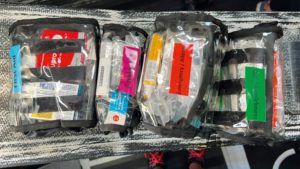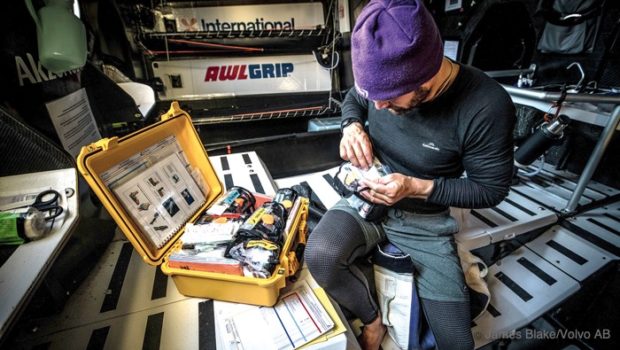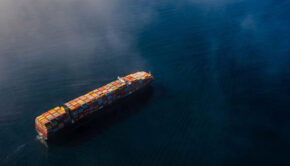What should the medical kit contain?
Published on November 17th, 2022
Putting together a ship’s medical kit is a lot like preparing a boat for a long voyage. It is about envisaging all the scenarios that could affect the health of you and your crew, and making sure you are ready with the skills and equipment to address them. Pip Hare, for Yachting World, runs through what to consider for the medical kit, particularly if you are heading offshore for an extended period.
Before each passage you’ll need to assess how far from help you’ll be at any given time and what level of medical care would be required on board to keep a casualty safe and stable until professional help can be accessed. This is something people often put to the back of their minds, I’m guilty of the same, always addressing how we can repair our boats, but not taking the same level of precaution with the humans sailing them.
A pragmatic approach is essential: we need to plan for the very worst but on the understanding that it is unlikely to happen, in the same way we carry a liferaft and assemble grab bags. We also need to accept the limitations of our abilities to deliver all medical care on board, but keep that risk in perspective. A good medical kit, support and training are the best way to manage the risk of getting ill or injured at sea.
Get trained and checked
Before setting off on an ocean voyage, I would recommend at least one member of the crew undertakes advanced medical training, appropriate for those who are not able to access professional medical help for days. If sailing double-handed then both co-skippers should take the training and if solo, special techniques to self-treatment will be needed.
The ability to treat and manage injuries and illness is in part down to your ability to diagnose problems early and prevent deterioration. When faced with needles, scalpels and the fragility of the human body even some of your strongest crew members may struggle, so get used to handling the kit and practicing techniques early.
Advanced training can be acquired through specialist offshore medical companies. A three-day advanced course with a non-marine based company will also teach you the skills to use the contents of your medical box, but may lack the context of patient management in a wet, moving, cramped environment.

Bag and label your medical kit into categories so you can find appropriate medicines quickly. Photo: Pip Hare/Medallia
It’s also worth investing in a medical check-up for every crew member considering a long voyage. These check-ups can be booked through private clinics.
Shore support
If you are not a medical professional it is well worth having a dedicated support service ashore who you can turn to for advice in an emergency. With many boats now carrying satcoms, it is sensible to have a medic on-hand who you can call and send pictures to if treating more advanced problems. This could be a friend, or there are specialist companies who offer on-call services for a fee. The medic ashore should have details of your crew and any known medical conditions, an inventory of your medical kit, and a copy of the same handbook you have aboard.
Your kit
Central to your kit should be a good medical handbook, I recommend finding one specifically written for sailing. Note this is not a first aid manual, it is a medical handbook so it has a greater depth of information.
It’s a good idea to organize your larger medical kit into smaller bags or boxes to target specific areas to avoid having to unpack the whole thing in an emergency. Keep a smaller day-to-day first aid kit at hand, regularly replenished, for minor problems such as headaches, milder seasickness and small cuts.
I keep my medical kit in a hard, waterproof Peli case, but on a more comfortable cruising boat a bag would suffice. Keep a list at the top of all the contents, subdivided into each smaller bag. For longer voyages you may wish to include expiry dates and always update it as the contents are used.
The following is how we organize our main medical kit for solo ocean racing, it’s by no means an exhaustive list and your own kit should be carefully planned with a medical professional to reflect your own crew and plans.
Analgesics
Every first aid kit will have some sort of pain relief. Start with paracetamol and ibuprofen, have a day-to-day supply in the first aid kit with top-ups of stronger medication in your medical kit.
For extended periods offshore consider prescription painkillers for more acute problems. The amount and type will depend on how big your crew is and how quickly you could get a casualty ashore. A good scenario to consider is broken bones, a patient that can be splinted and immobilized for a 2-3 day passage will have lesser requirements than a double-handed sailor mid-ocean.
For strong pain relief opiates and prescription anti-inflammatories will be necessary. Include anti-sickness medication in with the analgesics, as opiates can make many people sick. Always talk to a medical professional before giving opiates, and make sure you are aware of restricted substances, such as morphine, when travelling internationally.
Allergies
This box will cover allergic reactions but if any of your crew have known allergies or asthma and require an EpiPen or inhaler, their medication should be carried additionally and kept in the first aid bag or with their own kit. We include adrenaline for anaphylaxis, anti-histamines, steroids as well as GTN spray and aspirin to cover any cardiac problems.
Dressings and splints
This bag is for more serious damage to skin and bones. To use the contents well it’s important to keep up with regular training. For broken bones I carry plastic and inflatable splints, we also have the ability to make a plaster cast – this is a bandage that can be wetted then wound around a limb and will then set. We have a neck brace for C-spine immobilization.
For wounds we carry dressings of various sizes, gauze, steristrips and tape – be aware that many people are allergic to Elastoplast so carry an alternative fabric tape as well. Have plenty of these items as they’ll need to be frequently changed in wet environments.
Burns and scalds can be a huge problem at sea and are more likely injuries than open cuts; I carry a large volume of burns dressings, a roll of clingfilm to dress scalds, and disposable ice packs which can also be used to help reduce inflammation for sprains and soft tissue damage.
Seasickness
We carry seasickness tablets in the daily first aid kit. Sustained vomiting for any reason can lead to serious dehydration if not treated quickly when offshore. This bag also contains medication for other stomach ailments such as diarrhea, constipation and gastric reflux.
Seasickness can affect anyone and come on very suddenly so it’s a good idea to take medication to break the cycle. Those that have been sick for a while who are showing signs of dehydration should use rehydration sachets to replace electrolytes. In extreme cases of dehydration (over three days or severe fluid loss) intravenous (IV) rehydration could be essential. – Full story
Source: https://www.yachtingworld.com/cruising/how-to-put-together-a-yachts-medical-kit-141411








 We’ll keep your information safe.
We’ll keep your information safe.